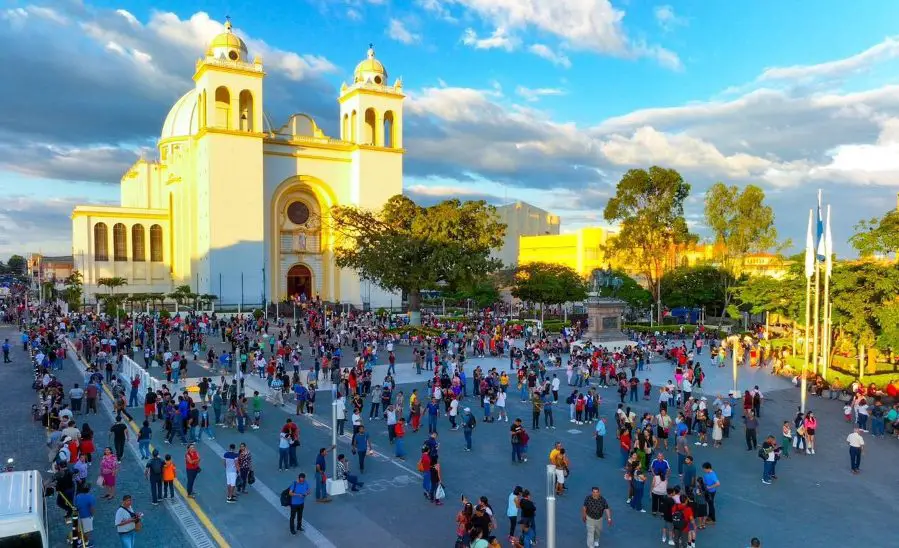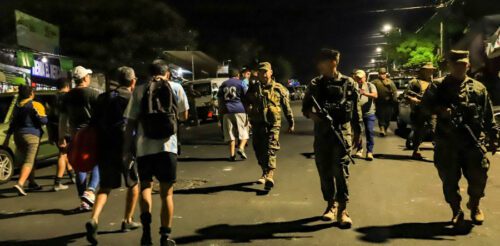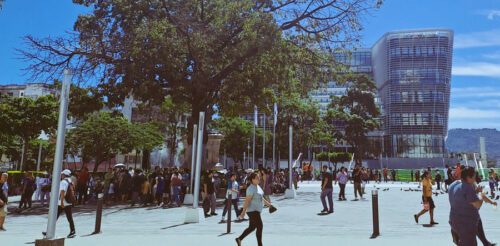According to the Multipurpose Household Survey (EHPM) released in 2023 by the Salvadoran Central Reserve Bank BCR, the population of El Salvador is 6,330,947, with 61.7% of the Salvadoran population living in urban areas and 38.3% in rural territory.
In 2022, the female population totaled 3,373,945, accounting for 53.3% of the overall population. Female numbers grew by 3,865, representing a 0.11% increase from 2021 to 2022.
El Salvador’s male population reached 2,957,002 in 2022, constituting 46.7% of total people. This represented an increment of 1,255 individuals, or 0.04%, compared to the previous year.
| 2021 | 2022 | 2022 Population Percentage |
Change 2021-2022 |
|
|---|---|---|---|---|
| Population | 6,325,827 | 6,330,947 | 100% | 5,120 |
| Female | 3,370,080 | 3,373,945 | 53.3% | 3,865 |
| Male | 2,955,747 | 2,957,002 | 46.7% | 1,255 |
Overall, El Salvador’s population increased by 5,120 from 2021 to 2022, an increment of 0.08%.
In El Salvador, females outnumber males by 6.6%. Nationally, there are 88 men for every 100 women. In urban areas, the ratio is 84 men for every 100 women, while in rural areas, it’s 93 men for every 100 women.
El Salvador’s population growth rate is expected to slow down in the upcoming years, mainly because of all the people leaving the country for political and economic reasons.

El Salvador Population by Department
The distribution of the population by departments indicates that almost 50 percent of the population is concentrated in 3 of the 14 departments.
San Salvador, La Libertad, and Santa Ana account for 3,093,343 Salvadorans, equal to 48.9% of the population.
In contrast, the three least populated departments, Cabañas, San Vicente, and Chalatenango, consolidate 506,915 people or 8% of the Salvadoran population.
| 2021 | 2022 | 2022 Population Percentage |
Change 2021-2022 |
|
|---|---|---|---|---|
| San Salvador | 1,733,576 | 1,732,068 | 27.4% | -1,508 |
| La Libertad | 797,543 | 800,920 | 12.7% | 3,377 |
| Santa Ana | 560,522 | 560,355 | 8.9% | -167 |
| Sonsonate | 502,727 | 504,581 | 8.0% | 1,854 |
| San Miguel | 465,394 | 464,558 | 7.3% | -836 |
| Ahuachapan | 362,681 | 365,128 | 5.8% | 2,447 |
| La Paz | 355,944 | 357,629 | 5.6% | 1,685 |
| Usulutan | 349,733 | 349,229 | 5.5% | -504 |
| Cuscatlan | 264,291 | 266,027 | 4.2% | 1,736 |
| La Union | 231,817 | 229,871 | 3.6% | -1,946 |
| Morazan | 193,369 | 193,666 | 3.1% | 297 |
| Chalatenango | 180,580 | 179,255 | 2.8% | -1,325 |
| San Vicente | 174,033 | 174,223 | 2.8% | 190 |
| Cabañas | 153,617 | 153,437 | 2.4% | -180 |
| Total | 6,325,827 | 6,330,947 | — | 5,120 |
Visit our “Departments and Municipalities” page to get a breakdown of the population of all 44 Salvadoran municipalities.
Salvadoran Population by Age Groups
Among the most important results obtained from the 2022 report is the representativeness of the young Salvadoran population between 15 and 29 years of age, with 25.8% of the total. “This information is crucial as it allows the government to observe the country’s productive potential,” stated the report.
Another relevant age group is the population between 7 and 14 years of age, which by 2022 represented 13.1% of the total. This indicator is significant due to the demand for education services.
| Age group | All | Urban | Rural |
|---|---|---|---|
| 0-6 | 9.9 | 8.7 | 12.0 |
| 7-14 | 13.1 | 12.1 | 14.6 |
| 15-29 | 25.8 | 24.9 | 27.1 |
| 30-59 | 37.1 | 38.9 | 34.0 |
| 60 Plus | 14.2 | 15.4 | 12.3 |
SEE ALSO: El Salvador Healthcare System. Healthcare in El Salvador.
Male and Female Population by Age Groups
When categorized by age brackets, the highest male population is in the 20-24 age group, totaling 280,064 individuals; the age group 5-9 is next with 270,279, and the 10-14 age group follows with 258,647 males.
Regarding female age groups, the largest population is in the 20-24 age category with 307,962 people, followed by the 25-29 group with 302,976 individuals, and the 30-34 group with 256,409.
| Age group | Male | Male % | Female | Female % |
|---|---|---|---|---|
| 80 Plus | 31,627 | 1.07% | 47,530 | 1.41% |
| 80-84 | 32,888 | 1.11% | 48,063 | 1.42% |
| 75-79 | 53,361 | 1.80% | 73,736 | 2.19% |
| 70-74 | 69,390 | 2.35% | 96,070 | 2.85% |
| 65-69 | 83,378 | 2.82% | 113,602 | 3.37% |
| 60-64 | 108,727 | 3.68% | 139,811 | 4.14% |
| 54-59 | 126,330 | 4.94% | 172,688 | 5.12% |
| 50-54 | 145,968 | 4.94% | 202,376 | 6.00% |
| 45-49 | 170,610 | 5.77% | 212,184 | 6.29% |
| 40-44 | 188,256 | 6.37% | 233,868 | 6.93% |
| 35-39 | 191,863 | 6.49% | 226,530 | 6.71% |
| 30-34 | 219,643 | 7.43% | 256,409 | 7.60% |
| 25-29 | 249,998 | 8.45% | 302,976 | 8.98% |
| 20-24 | 280,064 | 9.47% | 307,962 | 9.13% |
| 15-19 | 243,564 | 8.24% | 245,730 | 7.28% |
| 10-14 | 258,647 | 8.75% | 251,744 | 7.46% |
| 5-9 | 270,279 | 9.14% | 243,548 | 7.22% |
| 0-4 | 232,408 | 7.86% | 199,122 | 5.90% |
SEE ALSO: The Struggles of Living in Rural Areas of El Salvador.
In conclusion, the demographic makeup of El Salvador reflects a dynamic interplay of various age groups and gender distributions. With distinct population trends observed across different regions and age brackets.

 El Salvador Population
El Salvador Population


